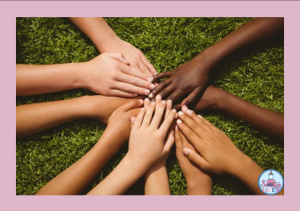
Throughout my life, I’ve had friends from all different races, cultures and religions. When I was a kid, my best friend, Lynn was African American, and we did everything together, we were true buds. So I learned at a young age that people are people are people. As I got older, I became more aware of the predjuce around me and couldn’t believe it. I just never understood how people could be so cruel just because of skin color. I joined many civil rights marches while in high school and college.
In the school system where I taught, it was predominantly white, Christian middle class. So… I used to love telling the kids that I am Jewish, just to see their reactions. Some of them chuckled, others were amazed and shocked. Many said they had never met a Jew before. As our talk continued, I found out that some came from homes where parents had never met a Jewish person either.
Eventually, some students from urban communities were bused into our district which was a great way for our kids to learn a little about diversity. I’d like to share a lesson with you that will help students realize that people are people no matter the color of their skin or how they look. The idea is to promote students’ acknowledgement of cultural uniqueness, ethnic, racial and cultural heritage and to promote harmony among them.
Find a book or movie about a culture that is not the same as most of your charges. Begin a discussion about this culture and discuss the similarities and differences between the book’s characters and themselves.
Take them to the school library where they can find a book about a culture or race that is not the same as theirs. While reading, have them pay close attention to traits, desires and values that the characters have which are similar to themselves and their families. Have them take notes.
They will then write a book report and put themselves in the place of one of the characters portrayed. They are to write it as if they are that person. Make sure that they include the following in their reports: How the person feels about his/her life, are they happy, what are some problems that they’ve faced, how have they overcome these problems, and how is their character similar to them? As a conclusion, they should add what they learned from this assignment.
Another idea you might use for the reports would be to have your kids write about a day in the life of one of the characters.
Once the assignment has been completed, have a class discussion about what they learned Talk about how it felt to put themselves in someone else’s shoes. Have they realized that people are both alike and different?
Book List that you will find helpful.
African American
The Watsons of Birmingham by- 1963 by Christopher Paul Curtis
The Skin I’m In by Sharon Flake
Monster by Walter Dean Meyers
Brown Girl Brownstones by Paule Marshall
Tituba of Salem Village by Anne Petry
Asian
Stanford Wong Flunks Big Time by Lisa Yee
Millicent Min Girl Genius by Lisa Yee
Cuban
Cuba 15 by Nancy Osa
Dominican Republic
How Tia Lola Came to Stay by Julia Alvarez
How the Garcia Girls Lost their Accents by Julia Alvarez
Iranian
Funny in Farsi by Firoozeh Dumas
Jewish/Arab Palestinian Conflict
Samir and Yonatan by Daniella Carmi
Habibi by Naomi Shihab
Running on Eggs by Anna Levine
Mexican
Esperanza Rising by Pam Munoz Ryan
The Circuit: Life of a Migrant Child by Francisco Jimenez
Crossing the Wire by Will Hobbs
Native American
The Absolute Diary of a Part-time Indian by Sherman Alexie
Far North by Will Hobbs
A Group of One by Rachna Gilmore

Leave a Reply